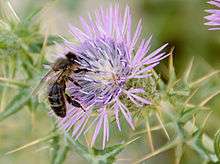Apis mellifera intermissa
| Apis mellifera intermissa | |
|---|---|
 | |
| Scientific classification | |
| Kingdom: | Animalia |
| Phylum: | Arthropoda |
| Class: | Insecta |
| Order: | Hymenoptera |
| Family: | Apidae |
| Genus: | Apis |
| Species: | A. mellifera |
| Trinomial name | |
| Apis mellifera intermissa Maa | |
Apis mellifera intermissa is an African sub-species of the Western honey bee.
Description
Previously classified as A.M.intermissa v. Buttel-Reepen[1][2][3] a reviewed classification of genus instead states the sub-species as A.M.intermissa v.Maa (M.S.Engel 1999)[4][5] Found in the south of Spain [6] and the (Maghreb) north of the Sahara desert in Africa, ranging from the east (Libya) to the west (Morocco),[7][8] and is adapted to dry climates.[2] This bee has a black-brown and orange striated abdomen and black-brown thorax with orange fur.[9][10][11][12]
Taxonomy
In a comparative study of five sub-species and A.m.iberica (Smith,Palopoli,Taylor,Garnery,Cornuet,Solignac,Brown 1991) cleavage maps obtained through the use of restriction enzyme [13] showed the Spanish Honey bee contains mtDNA similar to intermissa and also mellifera.[6] Additionally A.m.intermissa belongs to a group shown by experiment to have similar mtD.N.A (mitochondrian D.N.A.),this including monticola, scuttelata,andansonii and capensis [14][15][16]
In Spanish bee populations, mtDNA haplotypes of African bee strains were found to be frequently present (Smith 1991, Garnery et al 1995) (Cornuet et al 1975,1978, 1982, 1988; Ruttner 1988;Cornuet and Fresnaye 1989;Orante-Bermejos and Garcia-Fernandez 1995; Hepburn and Radloff 1996). Migrating bee populations formed the original colonies of bee in western Europe, landing to eventually populate the continent from Africa across the Straits of Gibraltar.[17]
See also
References
- ↑ "Honey bee breeds". save-bee.com. Retrieved 2013-06-07.
- 1 2 sociedadmi.info "Honey bees" Check
|url=value (help). - ↑ ENCYCLOPEDIE UNIVERSELLE DE LA LANGUE FRANCAISE - ABEILLES - APIDAE - APIS MELLIFERA - INTRODUCTION. encyclopedie-universelle website. Retrieved 2013-06-07.
- ↑ M.S.Engel google.co.uk The Taxonomy of Recent and Fossil Honey Bees (Hymenoptera :Apidae , Apis) J.HYM RES Vol 8(2) 1999 p.165-196 [Retrieved 2011-12-20]
- ↑ P. D. Evans [citing (Smith 1991), Garnery et al (1991), et al] books.google.co.uk(Google eBook) Advances in Insect Physiology, Volume 25 (345 pages) Academic Press, 25 Jul 1995 ISBN 0-12-024225-7 [Retrieved 2011-12-20]
- 1 2 D. R. Smith, M. F. Palopoli, B. R. Taylor, L. Garnery, J.-M. Cornuet, M. Solignac, W. M. Brown [jhered.oxfordjournals.org (The American Genetic Association 1991) Geographical Overlap of Two Mitochondrial Genomes in Spanish Honeybees (Apis mellifera iberica) The Journal of Heredity] Check
|url=value (help). Oxford University Press 03/01/1991. Retrieved 2011-12-19. - ↑ apiconsult.com website (Apiconsult 2006) a website dedicated to aiding and improving the livelihoods of people within Africa [Retrieved 2011-12-19]
- ↑ Mark L. Winston books.google.co.uk The biology of the honey bee (281 pages) Harvard University Press, 1 Apr 1991 ISBN 0-674-07409-2 [Retrieved 2011-12-19]
- ↑ Leen van 't Leven, Marieke Mutsaers, Piet Segeren, Hayo Velthuis books.google.co.uk AD32E Beekeeping in the tropics Agromisa Foundation[Retrieved 2011-12-19]
- ↑ David Wynick University of Bristol [2nd Apr 2008] from askabiologist.org.uk website
- ↑ "Netzwerk Biene". honey-bees.de. Retrieved 7 May 2015.
- ↑ Jalel l'apiculteur flickr.com [Retrieved 2011-12-20]
- ↑ "Restriction Maps". colostate.edu. Retrieved 7 May 2015.
- ↑ L Garnery, J M Cornuet and M Solignac pubget.com Evolutionary history of the honey bee Apis mellifera inferred from mitochondrial DNA analysis. Mol Ecol 1(3):145-54 (1992) PMID 1364272 doi:10.1111/j.1365-294X.1992.tb00170.x [Retrieved 2011-12-19]
- ↑ [John E. Dews, Eric Milner books.google.co.uk Breeding Better Bees (80 pages) WritersPrintShop, 2004 ISBN 1-904623-18-2 [Retrieved 2011-12-19]
- ↑ M.Chouchene, N. Barbouche, M.Garnery, L.Baylac openstarts.units.it Nimis P.L. Vignes Lebbe R (eds.) Tools for Identifying Biodiversity: Progress and Problems p.343 Molecular and ecophysiological characterisation of the Tunisian bee : Apis mellifera intermissa ISBN 978-88-8303-295-0 EUT,2010[Retrieved 2011-12-20]
- ↑ Pierre Franck, Lionel Garnery, Michel Solignac and Jean-Marie Cornuet (1997) JSTOR The Origin of West European Subspecies of Honeybees (Apis mellifera): New Insights from Microsatellite and Mitochondrial Data EvolutionVol. 52, No. 4 (Aug., 1998), pp. 1119-1134 (article consists of 16 pages) Published by: Society for the Study of Evolution [Retrieved 2011-12-22]
External links
| Wikimedia Commons has media related to Apis mellifera intermissa. |